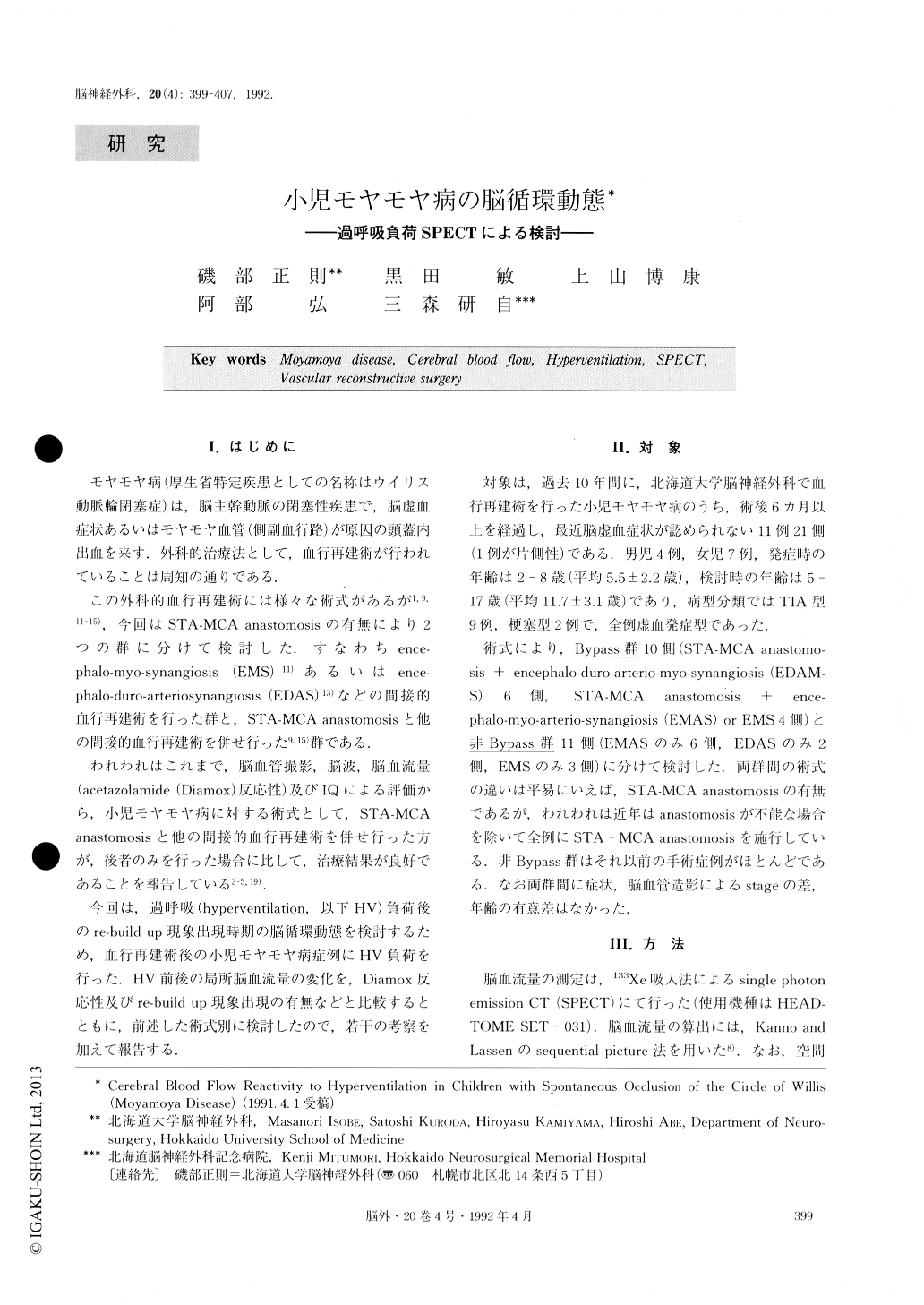Japanese
English
- 有料閲覧
- Abstract 文献概要
- 1ページ目 Look Inside
I.はじめに
モヤモヤ病(厚生省特定疾患としての名称はウイリス動脈輪閉塞症)は,脳主幹動脈の閉塞性疾患で,脳虚血症状あるいはモヤモヤ血管(側副血行路)が原因の頭蓋内出血を来す.外科的治療法として,血行再建術が行われていることは周知の通りである.
この外科的血行得建術には様々な術式があるが1,9,11-15),今回はSTA-MCA anastomosisの有無により2つの群に分けて検討した.すなわちence—phalo-myo-synangiosis(EMS)11)あるいはence—phalo-duro-arteriosynangiosis(EDAS)13)などの間接的血行再建術を行った群と,STA-MCA anastomosisと他の間接的血行再建術を併せ行った9,15)群である.
われわれはこれまで,脳血管撮影,脳波,脳血流量(acetazolamide(Diamox)反応性)及びIQによる評価から,小児モヤモヤ病に対する術式として,STA-MCAanastomosisと他の間接的血行再建術を併せ行った方が,後者のみを行った場合に比して,治療結果が良好であることを報告している2-5,19).
今回は,過呼吸(hyperventilation,以下HV)負荷後のre-build up現象出現時期の脳循環動態を検討するため,血行再建術後の小児モヤモヤ病症例にHV負荷を行った.HV前後の局所脳血流量の変化を,Diamox反応性及びre-build up現象出現の有無などと比較するとともに,前述した術式別に検討したので,若干の考察を加えて報告する.
To elucidate the relationship between cerebral blood flow (CBF) after hyperventilation (HV) and the re-build-up phenomenon on the encephaloelectrogram (EEG) in children with moyamoya disease, compara-tive study of CBF immediately after HV and CBF after administration of acetazolamide (Diamox) was ex-amined. CBF was measured by means of single photon emission CT (SPECT) using the 133Xe inhalation method. The subjects were 11 children (21 hemis-pheres) with moyamoya disease who were divided into two groups as follows,
1) Bypass group; who underwent STA-MCA anasto-mosis with other synangiosis.
2) Non-Bypass group; who underwent only some synangiosis such as EDAS, EMAS, EMS. The sum-mary of the results is shown below.
Regional CBF (rCBF) after HV of the frontal lobes in the Non-Bypass group had an evident tendency to show low perfusion compared with CBF in other re-gions. The correlation between low perfusion area after HV, and areas where the increase of rCBF is less after administration of acetazolamide became clear. The strongest relation was observed between low perfusion after HV and re-build-up phenomenon on EEG. On the other hand, rCBF after HV of the frontal lobes in the Bypass group had, compared with other regions, no tendency to show low perfusion.
From this study and our previous reports, it is assumed that there is some hemodynamic insufficiency in the frontal lobes of the Non-Bypass group. The reason why the reduction of rCBF was less after HV especially in the frontal lobes of the Bypass group is still unknown. But, most of anterior branches of STA were used for the anastomosis and the craniotomy of the Bypass group was made in a more anterior position than that of the Non-Bypass group. These surgical pro-cedures are estimated to bring about a much better col-lateral blood flow to the frontal lobes.

Copyright © 1992, Igaku-Shoin Ltd. All rights reserved.


